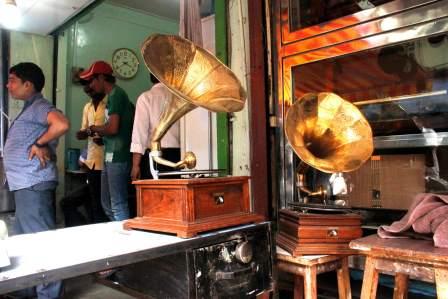Arts
Musical Time Machine

Today, the most famous address for finding the original 78 RPMs is Mutton Street of ancient Bhendi Bazaar inMumbai.
Imagine a “spy” headed to the gallows requesting that his last wish is to enjoy the songs of a 78 RPM gramaphone record.
This is neither a joke nor an impossible Bollywood filmy plot. Jyotish Chandra Bose, made the request a day before his hanging at Alipore Central Jail in Calcutta to enjoy the songs of Kanan Devi. His cohorts in crime, Haridas Mitra (father of Dr. Amit Mitra, the present Finance Minister of West Bengal) and Amar Singh Gill, thought, he had turned mad. Mitra burst out laughing, forgetting that he too was to be hanged.
The trio, spies of the Indian National Army (INA) of Netaji Subhash Chandra Bose, were caught in Calcutta, tried for high treason by the British Raj and sentenced to death.
 Here is the climax of this 78 RPM-story. At the last minute, their capital punishment was commuted to life imprisonment, thanks to the efforts of Mahatma Gandhi, himself a great lover of Kanan Devi’s song.
Here is the climax of this 78 RPM-story. At the last minute, their capital punishment was commuted to life imprisonment, thanks to the efforts of Mahatma Gandhi, himself a great lover of Kanan Devi’s song.
78 RPMs recorded the outbursts of “Chalo Dilli (Delhi)” or “Tum Mujhe Khoon Do, Mein Tumhe Azadi Dunga” of Netaji, or the famous war song “Kadam Kadam Barhai Jaa” of the INA-soldier Laxmi Sehegal.
Few remember that the speeches of Netaji, Gandhi, Jawaharlal Nehru and other freedom fighters used to be recorded on the 78 RPMs, as were the poetic recitation of Rabindranath Tagore and Sarojini Naidu.
78 RPM Address
Today, the most famous address for finding the original 78 RPMs is Mutton Street of ancient Bhendi Bazaar in Mumbai. It India’s most famous “Chore Bazaar,” where you can find anything and everything.
The NRI’s, officials of the All India Radio (AIR) and Doordarshan (DD), top music directors, lyricists, researchers, writers, collectors of antiques, research scholars and firangi record importers throng here regularly. The vintage songs that are missing from AIR, Film Division and DD archives may well be found here.
When Mumbai’s National Centre for the Performing Arts decided to create an archives of Indian singers, the demand for 78 RPMs grew.
It is here that the Bhendi Bazaar Gharana of classical Hindustani music had developed 124 years ago. Lata Mangeshkar, Asha Bhonsle, Manna Dey, Pankaj Udhas and Mahendra Kapur belonged to this musical Gharana.
78 RPM: Nostalgia for NRIs
Old 78 RPM’s are source of great nostalgia for the NRIs. They readily pay Rs. 6,500 for a single 78 RPM record from 1935. In that year, its cost was just 12 annas.
The NRIs, some old, some middle aged and some young, throng here regularly, many spending hours examining titles from the sheaf of records. Few young NRIs know Kanan Devi or recognize the intoxicating the “soor” (melody) of Suraiya. Some of them will come armed with lists and then head quickly for Desi food stalls in the neighborhood. They come here as a matter of compulsion for their grandparents.
Khandani, Faltoo or Chaloo? There are three classifications of 78 RPMs — Khandani, Bekar or Chaloo.
“Khandani” are songs produced between 1920 and 1949, including vintage-melodies of Mubarak Begum, folk singer Surinder Kaur, Yamla Jatt, Begum Akhtar, Bade Ghulam Ali Khan or Uma Devi (film actress Tun Tun). 78 RPMs of Noorjehan, Shamshad Begum, Malika Pukhraj and K.L.Sehgal fall in this category. NRIs readily pay Rs. 5000 for a single a 78 RPM vintage of Meena Kapoor, K.L. Sehgal or Noor Jehan.
Chaloo are 78 RPMs produced between 1950 and 1985, covering songs of Pakeezah, Bobby, Ghumnaam, Baat Ek Raat Ki, Pyasa, or Jhanak Jhanak Payal Baje.
“Bekar” or “Faltoo,” literally meaning useless, are the most valuable records, in contradiction of their market lingo. Gems, not junks, they were published before 1919 and are now rarely available. A large numbers of those records moved to Pakistan, Bangladesh, Mayanmar and England after the partition of India in 1947.
The Matrix
The matrix number 13024, India’s first 78 RPM gramophone record, is the costliest record, yet a “Bekar” in Bhendi Bazaar’s market lingo. The singer Shoshimukhi of this matrix sang a Bengali song whose first line was ‘Ami ki shojonee kusumeri.’
 On Nov. 8, 1902, Hen Frederick William Geisberg recorded it in a Calcutta hotel. Two days later, he recorded the songs of Fani Bala, another Bengali singer. Another invaluable “Faltoo” is matrix number 13029 – Tarana and Dadra (Hindustani classical school of music) by Saila Bai. Saila’s shellac series was 13029 to 13036.
On Nov. 8, 1902, Hen Frederick William Geisberg recorded it in a Calcutta hotel. Two days later, he recorded the songs of Fani Bala, another Bengali singer. Another invaluable “Faltoo” is matrix number 13029 – Tarana and Dadra (Hindustani classical school of music) by Saila Bai. Saila’s shellac series was 13029 to 13036.
The famous “Bekars” are molten melodies of Gauhar Jaan, recorded by Geisberg in Calcutta on Nov. 11, 1902. After Saila’s session was over, Geisberg asked Gauhar, a singer of American origin, to sing. Gauhar sang a Dadra and the matrix number of that 78 RPM was 13037.
Names of the singers were announced at the end of the record. The tradition continued from 1902 till 1908, the year the Gramophone Company of England launched its first manufacturing unit at Sealdah in Calcutta.
78 RPMs come to Bhendi Bazaar from all over India. The Mumbai dealers have deployed a large number of “agents” in Delhi, Chandigarh, Kolkata, Shimla, Meerut, Kanpur, Burdhaman, Amritsar, Jallandhar, Patiala, Guwahati, Lucknow, Allahabad, Varanasi, Jaipur, Patna, Bhopal and other places to procure the records.
These “agents” are well-versed in the logo, or trademarks, of different companies, such as HMV, Young India, New Theatres, Lahore Music Company, Gramophone Company, Bombay’s Broadcast Record Columbia, Odeon, Hindustan Records.
